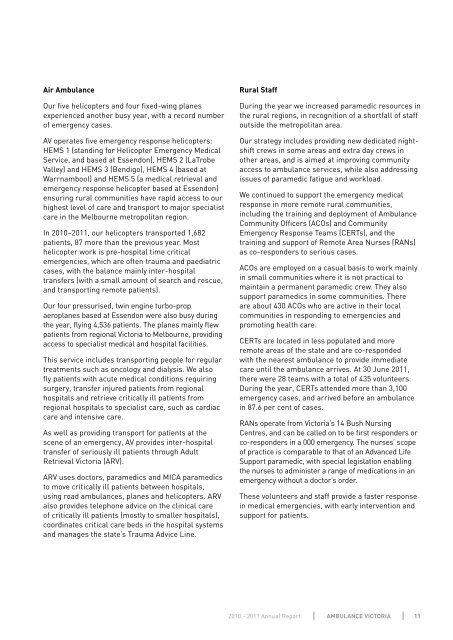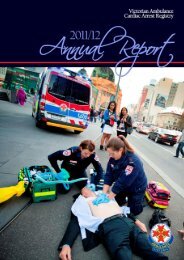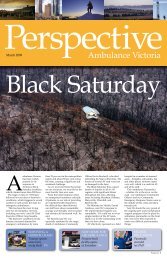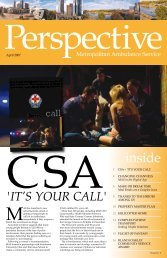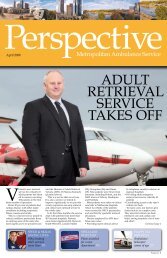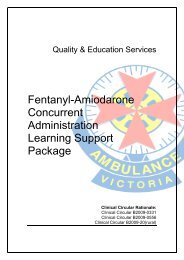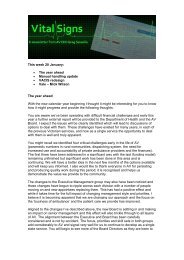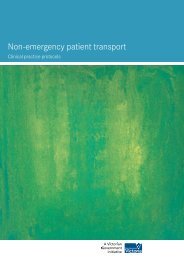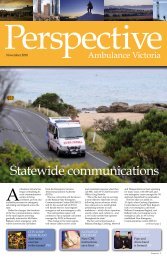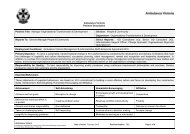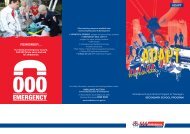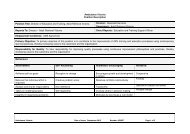AMBULANCE VICTORIA 2010-2011 ANNUAL REPORT
AMBULANCE VICTORIA 2010-2011 ANNUAL REPORT
AMBULANCE VICTORIA 2010-2011 ANNUAL REPORT
Create successful ePaper yourself
Turn your PDF publications into a flip-book with our unique Google optimized e-Paper software.
Air Ambulance<br />
Our five helicopters and four fixed-wing planes<br />
experienced another busy year, with a record number<br />
of emergency cases.<br />
AV operates five emergency response helicopters:<br />
HEMS 1 (standing for Helicopter Emergency Medical<br />
Service, and based at Essendon), HEMS 2 (LaTrobe<br />
Valley) and HEMS 3 (Bendigo), HEMS 4 (based at<br />
Warrnambool) and HEMS 5 (a medical retrieval and<br />
emergency response helicopter based at Essendon)<br />
ensuring rural communities have rapid access to our<br />
highest level of care and transport to major specialist<br />
care in the Melbourne metropolitan region.<br />
In <strong>2010</strong>–<strong>2011</strong>, our helicopters transported 1,682<br />
patients, 87 more than the previous year. Most<br />
helicopter work is pre-hospital time critical<br />
emergencies, which are often trauma and paediatric<br />
cases, with the balance mainly inter-hospital<br />
transfers (with a small amount of search and rescue,<br />
and transporting remote patients).<br />
Our four pressurised, twin engine turbo-prop<br />
aeroplanes based at Essendon were also busy during<br />
the year, flying 4,536 patients. The planes mainly flew<br />
patients from regional Victoria to Melbourne, providing<br />
access to specialist medical and hospital facilities.<br />
This service includes transporting people for regular<br />
treatments such as oncology and dialysis. We also<br />
fly patients with acute medical conditions requiring<br />
surgery, transfer injured patients from regional<br />
hospitals and retrieve critically ill patients from<br />
regional hospitals to specialist care, such as cardiac<br />
care and intensive care.<br />
As well as providing transport for patients at the<br />
scene of an emergency, AV provides inter-hospital<br />
transfer of seriously ill patients through Adult<br />
Retrieval Victoria (ARV).<br />
ARV uses doctors, paramedics and MICA paramedics<br />
to move critically ill patients between hospitals,<br />
using road ambulances, planes and helicopters. ARV<br />
also provides telephone advice on the clinical care<br />
of critically ill patients (mostly to smaller hospitals),<br />
coordinates critical care beds in the hospital systems<br />
and manages the state’s Trauma Advice Line.<br />
Rural Staff<br />
During the year we increased paramedic resources in<br />
the rural regions, in recognition of a shortfall of staff<br />
outside the metropolitan area.<br />
Our strategy includes providing new dedicated nightshift<br />
crews in some areas and extra day crews in<br />
other areas, and is aimed at improving community<br />
access to ambulance services, while also addressing<br />
issues of paramedic fatigue and workload.<br />
We continued to support the emergency medical<br />
response in more remote rural communities,<br />
including the training and deployment of Ambulance<br />
Community Officers (ACOs) and Community<br />
Emergency Response Teams (CERTs), and the<br />
training and support of Remote Area Nurses (RANs)<br />
as co-responders to serious cases.<br />
ACOs are employed on a casual basis to work mainly<br />
in small communities where it is not practical to<br />
maintain a permanent paramedic crew. They also<br />
support paramedics in some communities. There<br />
are about 430 ACOs who are active in their local<br />
communities in responding to emergencies and<br />
promoting health care.<br />
CERTs are located in less populated and more<br />
remote areas of the state and are co-responded<br />
with the nearest ambulance to provide immediate<br />
care until the ambulance arrives. At 30 June <strong>2011</strong>,<br />
there were 28 teams with a total of 435 volunteers.<br />
During the year, CERTs attended more than 3,100<br />
emergency cases, and arrived before an ambulance<br />
in 87.6 per cent of cases.<br />
RANs operate from Victoria’s 14 Bush Nursing<br />
Centres, and can be called on to be first responders or<br />
co-responders in a 000 emergency. The nurses’ scope<br />
of practice is comparable to that of an Advanced Life<br />
Support paramedic, with special legislation enabling<br />
the nurses to administer a range of medications in an<br />
emergency without a doctor’s order.<br />
These volunteers and staff provide a faster response<br />
in medical emergencies, with early intervention and<br />
support for patients.<br />
<strong>2010</strong> - <strong>2011</strong> Annual Report <strong>AMBULANCE</strong> <strong>VICTORIA</strong> 11


